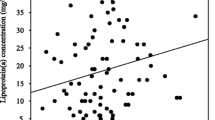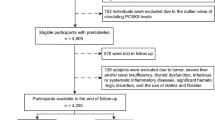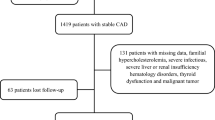Abstract
Objective
To investigate the association of resistin with proprotein convertase subtilisin–kexin type 9 (PCSK9) levels, another novel regulator of atherosclerosis, in the condition of coronary artery disease (CAD).
Research design and methods
We prospectively enrolled a total of 356 consecutive stable CAD patients who were not treated with lipid-lowering drugs in the present study. The baseline clinical characteristics were collected. Plasma PCSK9 and resistin levels were determined by ELISA. The relationship between plasma PCSK9 and resistin levels was investigated.
Results
Overall, plasma resistin exhibited a positive nonparametric correlation with PCSK9 levels (r = 0.123, p = 0.02). When the patients were classified into groups based on body mass index (BMI), the resistin correlated significantly to the PCSK9 levels in patients with BMI < 25 kg/m2 (r = 0.162, p = 0.026) but not in patients with BMI ≥ 25 kg/m2 (r = 0.087, p = 0.205). Multivariate regression analysis corroborated the relation between the PCSK9 and an elevated resistin level in patients with BMI < 25 kg/m2 independently of traditional parameters including age, sex, BMI, smoking, family history of CAD, systolic blood pressure, glucose, low density lipoprotein cholesterol, white blood cell, neutrophil to lymphocyte ratio, and high-sensitive C-reactive protein.
Conclusions
Plasma resistin was positively related to PCSK9 levels in CAD patients with normal weight, suggesting that the circulating resistin might represent a link with PCSK9 level variations in CAD progression of normal body weight.

Similar content being viewed by others
Abbreviations
- CAD :
-
Coronary artery disease
- BMI :
-
Body mass index
- SBP :
-
Systolic blood pressure
- DBP :
-
Diastolic blood pressure
- TC :
-
Total cholesterol
- LDL-C :
-
Low density lipoprotein cholesterol
- HDL-C :
-
High density lipoprotein cholesterol
- Apo :
-
Apolipoprotein
- WBC :
-
White blood cell
- NLR :
-
Neutrophil to lymphocyte ratio
- hs-CRP :
-
High-sensitive C-reactive protein
- PCSK9 :
-
Proprotein convertase subtilisin/kexin type 9
References
Mendis S, Chestnov O (2014) The global burden of cardiovascular diseases: a challenge to improve. Curr Cardiol Rep 16(5):486
Wang JC, Bennett M (2012) Aging and atherosclerosis: mechanisms, functional consequences, and potential therapeutics for cellular senescence. Circ Res 111(2):245–259
van Diepen JA, Berbee JF, Havekes LM et al (2013) Interactions between inflammation and lipid metabolism: relevance for efficacy of anti-inflammatory drugs in the treatment of atherosclerosis. Atherosclerosis 228(2):306–315
Steppan CM, Bailey ST, Bhat S et al (2001) The hormone resistin links obesity to diabetes. Nature 409(6818):307–312
Holcomb IN, Kabakoff RC, Chan B et al (2000) FIZZ1, a novel cysteine-rich secreted protein associated with pulmonary inflammation, defines a new gene family. EMBO J 19(15):4046–4055
de Luis DA, Sagrado MG, Conde R et al (2010) Relation of resistin levels with cardiovascular risk factors, insulin resistance and inflammation in naive diabetes obese patients. Diabetes Res Clin Pract 89(2):110–114
Melone M, Wilsie L, Palyha O et al (2012) Discovery of a new role of human resistin in hepatocyte low-density lipoprotein receptor suppression mediated in part by proprotein convertase subtilisin/kexin type 9. J Am Coll Cardiol 59(19):1697–1705
Abifadel M, Varret M, Rabes JP et al (2003) Mutations in PCSK9 cause autosomal dominant hypercholesterolemia. Nat Genet 34(2):154–156
Lambert G, Charlton F, Rye KA et al (2009) Molecular basis of PCSK9 function. Atherosclerosis 203(1):1–7
Stein EA, Raal FJ (2013) Insights into PCSK9, low-density lipoprotein receptor, and low-density lipoprotein cholesterol metabolism: of mice and man. Circulation 127(24):2372–2374
Wu NQ, Li JJ (2014) PCSK9 gene mutations and low-density lipoprotein cholesterol. Clin Chim Acta 431:148–153
Kwakernaak AJ, Lambert G, Dullaart RP (2012) Relationship of proprotein convertase subtilisin-kexin type 9 levels with resistin in lean and obese subjects. Clin Biochem 45(16–17):1522–1524
Hampton EN, Knuth MW, Li J et al (2007) The self-inhibited structure of full-length PCSK9 at 1.9 A reveals structural homology with resistin within the C-terminal domain. Proc Natl Acad Sci 104(37):14604–14609
Rashid S, Kastelein JJ (2013) PCSK9 and resistin at the crossroads of the atherogenic dyslipidemia. Expert Rev Cardiovasc Ther 11(11):1567–1577
Li S, Guo YL, Xu RX et al (2014) Association of plasma PCSK9 levels with white blood cell count and its subsets in patients with stable coronary artery disease. Atherosclerosis 234(2):441–445
Li S, Guo YL, Xu RX et al (2014) Plasma PCSK9 levels are associated with the severity of coronary stenosis in patients with atherosclerosis. Int J Cardiol 174:873–874
Guo YL, Liu J, Xu RX et al (2013) Short-term impact of low-dose atorvastatin on serum proprotein convertase subtilisin/kexin type 9. Clin Drug Investig 33(12):877–883
Li JJ, Nie SP, Qian XW et al (2009) Chronic inflammatory status in patients with coronary artery ectasia. Cytokine 46(1):61–64
Hong LF, Li XL, Luo SH et al (2014) Relation of leukocytes and its subsets counts with the severity of stable coronary artery disease in patients with diabetic mellitus. PLoS ONE 9(3):e90663
Baass A, Dubuc G, Tremblay M et al (2009) Plasma PCSK9 is associated with age, sex, and multiple metabolic markers in a population-based sample of children and adolescents. Clin Chem 55(9):1637–1645
Cariou B, Le May C, Costet P (2011) Clinical aspects of PCSK9. Atherosclerosis 216(2):258–265
Steppan CM, Lazar MA (2004) The current biology of resistin. J Intern Med 255(4):439–447
Bo S, Gambino R, Pagani A et al (2005) Relationships between human serum resistin, inflammatory markers and insulin resistance. Int J Obes (Lond) 29(11):1315–1320
Shetty GK, Economides PA, Horton ES et al (2004) Circulating adiponectin and resistin levels in relation to metabolic factors, inflammatory markers, and vascular reactivity in diabetic patients and subjects at risk for diabetes. Diabetes Care 27(10):2450–2457
Ohmori R, Momiyama Y, Kato R et al (2005) Associations between serum resistin levels and insulin resistance, inflammation, and coronary artery disease. J Am Coll Cardiol 46(2):379–380
Reilly MP, Lehrke M, Wolfe ML et al (2005) Resistin is an inflammatory marker of atherosclerosis in humans. Circulation 111(7):932–939
Jamaluddin MS, Weakley SM, Yao Q et al (2012) Resistin: functional roles and therapeutic considerations for cardiovascular disease. Br J Pharmacol 165(3):622–632
Choi HY, Kim S, Yang SJ et al (2011) Association of adiponectin, resistin, and vascular inflammation: analysis with 18F-fluorodeoxyglucose positron emission tomography. Arterioscler Thromb Vasc Biol 31(4):944–949
Urban D, Poss J, Bohm M et al (2013) Targeting the proprotein convertase subtilisin/kexin type 9 for the treatment of dyslipidemia and atherosclerosis. J Am Coll Cardiol 62(16):1401–1408
Hotamisligil GS (2003) The irresistible biology of resistin. J Clin Invest 111(2):173–174
Acknowledgments
This work was partially supported by the National Natural Scientific Foundation (81070171, 81241121), the Specialized Research Fund for the Doctoral Program of Higher Education of China (20111106110013), the Capital Special Foundation of Clinical Application Research (Z121107001012015), the Capital Health Development Fund ( 2011400302), and the Beijing Natural Science Foundation (7131014) awarded to Dr. Jian-Jun Li, MD, PhD.
Conflict of interest
The authors declare that they have no conflict of interest.
Ethical approval
All procedures performed in studies involving human participants were in accordance with the ethical standards of the institutional and/or national research committee and with the 1964 Helsinki declaration and its later amendments or comparable ethical standards.
Informed consent
Informed consent was obtained from all individual participants included in the study.
Author information
Authors and Affiliations
Corresponding author
Rights and permissions
About this article
Cite this article
Li, S., Xu, R.X., Zhang, Y. et al. Relation of resistin to proprotein convertase subtilisin–kexin type 9 levels in coronary artery disease patients with different nutritional status. J Endocrinol Invest 38, 1291–1299 (2015). https://doi.org/10.1007/s40618-015-0310-y
Received:
Accepted:
Published:
Issue Date:
DOI: https://doi.org/10.1007/s40618-015-0310-y




